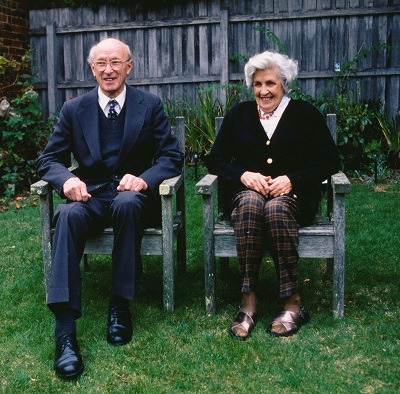THE KEN AND JOAN PLOMLEY COLLECTION OF MODERNIST ART
Kenneth Francis Plomley (1916 – 2012)
(Barbara) Joan Plomley (1925 – 2018)
The art collection gathered together by Ken and Joan Plomley is a microcosm of early Australian modernism. It features an array of notable artists of which, significantly, almost half are women. One key section focuses on the lino-cut prints of the Grosvenor School, whilst a second surveys the career of the pioneer modernist Roy de Maistre, a distant cousin of Ken through his great-uncle Etienne de Mestre, father of Roy. As a child of about 10, Ken lived for a year with Etienne’s widow, his great-aunt Clara and Roy’s sister Biddy in the rural village of Moss Vale in the southern highlands of New South Wales. Etienne de Mestre was the famed horse trainer, who won the Melbourne Cup five times in the race’s first eighteen years, a feat unsurpassed until the arrival of Bart Cummings in the 1970s. On Etienne’s death in 1916, the year of Ken’s birth, the de Mestre family lived in Mt Valdemar, a distinguished mansion in Sutton Forest, now owned by Nicole Kidman and Keith Urban.
PLOMLEY COLLECTION - Supplementary Image.jpg

KEN AND JOAN PLOMLEY
IN THE GARDEN,
GLEN IRIS, MELBOURNE
Ken became interested in early Australian life as a boy and made his first art purchase, a print of colonial Sydney, at the age of fourteen. At Sydney University he studied the agricultural methods of the early settlers and completed a B.Sc. (Agriculture) in 1938. Following the outbreak of World War II, he joined the Navy in 1942 and embarked on an officer’s training course in Melbourne, but was diverted into the Naval Victualling Laboratory in St Kilda Road. Here the navy considered he would be of more use to the war effort, working on the huge task of providing naval personnel with enough food, drink and supplies to keep them fighting fit, in whatever part of the globe they might be stationed.
One of his talented staff was Joan, who had been recommended straight from school for a job in the Laboratory by her science teacher at Presbyterian Ladies’ College. Together, they helped develop food survival packages for crews whose vessels had been sunk; and in September 1946, Ken took up a position at the Division of Forest Products, CSIRO, in South Melbourne. Three months later, Ken and Joan were married, resulting in a long and happy union of 66 years. At the CSIRO, he became a Principal Research Scientist, described by a colleague as being “the epitome of the perfect gentleman, honourable and cultured, a quiet but very significant scientific achiever. He conducted pioneering work on the use of extractives from the bark of various tree species, which in turn formed the basis for the establishment of the structural wood composites industry, utilising renewable adhesives”. Ken retired in 1981.
As his art and book collecting expanded, Ken formed close professional relationships with several dealers including Joan McClelland of Joshua McClelland Print Room, and the renowned Dr Joseph Brown. Joan Plomley was always very interested and supportive of Ken’s interest in art and involved in decisions about new acquisitions. The purchase of the painting by Arnold Shore, for example, was no doubt influenced by her connection to the artist who used to stay at the same guest house at Mount Macedon when Joan was a child. Ken’s relationship to the de Mestre family resulted in one of the largest private collections of Roy de Maistre’s paintings in this country. Notable examples here include The Meeting in the Garden, 1929, which records the events of the ground-breaking Burdekin House Exhibition of that same year, and Figure with Guitar, c.1932 – 35, a large oval painting which highlights the artist’s fascination with Cubist technique. The Grosvenor School works include two examples by the school’s teacher Claude Flight, as well as key prints from students such as Dorrit Black, Ethel Spowers and Evelyn Syme. Margaret Preston is also strongly represented with a major early still life painting and a group of five prints. The Queensland modernist Kenneth Macqueen was another Plomley favourite and five of his distinctive watercolours are also featured.
Of the colonial images, one significant work is the haunting portrait of Fanny Hardwicke which is referred to in Friendly Mission, a book published in 1966, written by Ken’s older brother Brian, an authority on the history and culture of Aboriginal Tasmanians. Here, he mentions Fanny who at one time would have “belonged” to Charles Browne Hardwicke’s household at Norfolk Plains.
When Ken Plomley sold his extensive collection of rare books in 2002, collectors around Australia were astounded by the treasures it contained as well as the depth of research knowledge it revealed. The collection of artworks on offer here is similarly remarkable.